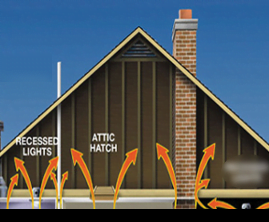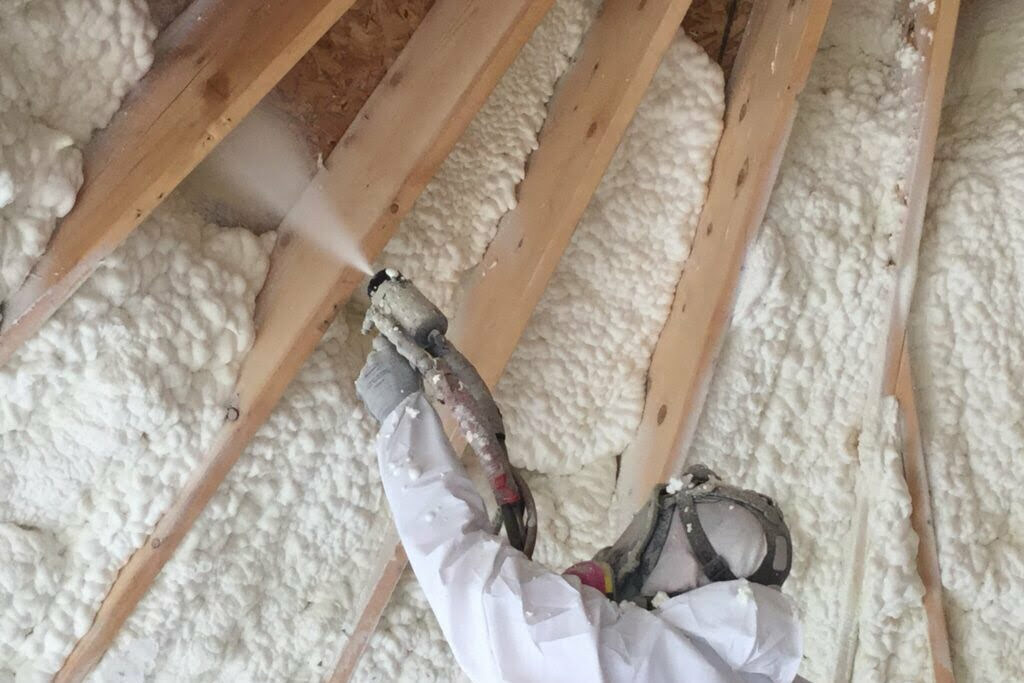As homeowners across the United States seek more energy-efficient solutions for their homes, the benefits of spray foam insulation attic spaces can be leveraged to improve heat retention and cost-savings are more important than ever. Whether you’re looking to retrofit your older home or you’re exploring insulation options for a new build, we’ll give you the info you need to help you decide if spray foam insulation is the right choice for your attic.
The Importance of Attic Efficiency
Attic efficiency plays a huge role in the overall energy efficiency of your home. An inefficient attic can lead to a number of issues including increased energy bills, discomfort inside the home, and even potential damage from moisture and mold. On the other hand, a well-insulated and efficient attic can contribute to significant energy savings, improved home air quality, and a comfortable indoor environment.
How Spray Foam Can Help
Attics are one of the most important areas to insulate properly in a home, yet they often present challenges. Factors like heat gain and loss, humidity, air leakage, and accessibility can make attic insulation difficult. Fortunately, spray foam insulation provides an elite solution specifically suited for attic environments. Its superior air sealing, moisture resistance, and insulation make it a great option for attic efficiency.
What Exactly Is Spray Foam Insulation?
Spray foam insulation starts out as liquid components that are sprayed onto surfaces using special equipment and rapidly expand to coat and seal cracks, gaps, and voids. Unlike traditional insulation that comes in rolls or batts, spray foam fully adheres to surfaces sealing out air infiltration. It also hardens providing structure and insulation value.
Key Benefits of Spray Foam for Attics
Spray foam insulation provides numerous advantages specifically for attic environments:
Superior Insulation and Air Sealing
Spray foam adheres seamlessly to surfaces and seeps into cracks, expanding to seal voids that allow energy-robbing air transfer. This maximizes insulation performance, unlike batt insulation, which can leave gaps. Foam prevents air leakage better than fiberglass.
Prevents Moisture Buildup and Condensation
Foam forms an airtight barrier keeping humid interior air from entering the attic. This is vital for attic efficiency and comfort. In cold climates, this air seal minimizes condensation buildup from contact with cold roof decking. Condensation left unchecked can rot wood, warp roof sheathing and lead to mold growth.
Long Lasting and Durable
Unlike fiberglass or cellulose which can settle and degrade over time, spray foam maintains its monolithic insulation barrier for decades after installation. It will not sag or shift, keeping insulation levels and air tightness consistent year after year. Properly installed foam lasts over 50 years.
Seamless Coverage and Gap Filling Ability
One of spray foam’s major assets is its ability to fully adhere to any shape, easily coating around obstructions and expanding into cracks. Blanket insulation cannot conform around complex angles, chimneys, wiring, or plumbing.
Helps Prevent Ice Dams
By keeping warm interior air from reaching the attic, spray foam minimizes situations where roof snow melts and refreezes at the eaves causing damaging ice dam formation. Preventing heat loss is key to enjoying a comfortable home environment and savings on energy bills.
Can Encapsulate Ductwork
Coating HVAC ductwork that runs through the attic with spray foam adds a highly efficient insulation barrier that minimizes heating and cooling losses. Doing so results in substantial energy savings.
Helps Regulate Attic Temperature
The superior air-sealing properties of foam also help minimize extreme temperature swings in the attic throughout the year. This added stability enhances efficiency.
How to Install Spray Foam Properly
Unless you’re a trained spray foam insulation specialist, it’s not recommended to install spray foam yourself. Instead, hire a qualified pro insulation company that knows the proper safety procedures during the application process. Improper technique or inadequate PPE with DIY installation can put you at risk, so be sure to contact a reputable, experienced company like Cincinnati RetroFoam.
Spray Foam and Energy Efficiency
In addition to the performance benefits directly for your attic, spray foam insulation also provides whole home energy efficiency improvements:
How Spray Foam Improves Home Energy Efficiency
The robust insulation, air sealing, and humidity control provided by spray foam in the attic allow your home’s HVAC system to operate much more efficiently. Less treated air escapes due to fewer gaps. With less heat transfer in and out, your system doesn’t labor as hard to maintain desired temperatures.
Homeowners often see substantial energy cost savings after proper foam insulation installation. These savings continue year after year over the lifetime of the foam.
Potential Eligibility for Energy Efficiency Tax Credits
Depending on the specific type of spray foam installed and the overall project costs, the installation job may qualify for energy efficiency tax credits under federal and local programs. Your insulation contractor can advise you on program qualifications and the application documentation needed. This can make the project more affordable.
Long-Term Cost Savings
The dramatic long-term energy savings and exceptional durability of spray foam make it a smart investment in most climate zones. Factoring in energy savings and tax credits, payback periods of just a few years are common.
Ongoing utility savings continue to accrue over the 50+ year lifetime of the foam. Added comfort and home performance are difficult to quantify but provide real benefits.
Key Takeaways on Spray Foam Benefits
- Air seals and insulates superiorly
- Resists moisture and condensation
- Won’t degrade or settle over time
- Fills gaps and adheres to any surface
- Helps prevent ice dams
- Can encapsulate ducts
- Enables an unvented attic
- Qualifies for tax credits
For attic insulation that optimizes energy efficiency through incredible insulation, thorough air sealing, and humidity control, spray foam is unmatched. Just be sure to hire certified pros like the experts at Cincinnati RetroFoam to leverage its many benefits. Your investment will pay dividends for decades to come.
Choose Spray Foam Insulation from Cincinnati RetroFoam
With certified expertise in optimal spray foam application, precision installation techniques, attic ventilation guidance, infrared imaging to ensure seamless coverage, ductwork encapsulation services, and tax credit expertise, Cincinnati RetroFoam provides homeowners with superior quality spray foam insulation with maximized energy efficiency. Our strict protocols confirm that there are no gaps left over after installation, ensuring your spray foam insulation achieves rated R-values, seals thoroughly for air tightness, and optimizes your attic performance. For the best spray foam attic insulation, choose Cincinnati RetroFoam.
FAQs
Does my attic need more ventilation with spray foam?
Potentially. A non-vented attic approach may work better. Discuss optimal attic ventilation with spray foam installation professionals.
How long does spray foam insulation last?
Properly installed spray foam can provide consistent insulation performance for over 50 years with no settling or degradation compared to other insulations. It’s a long-term investment.
Is spray foam worth it in the attic?
Spray foam insulation in the attic can be a worthwhile investment for some homeowners. The main benefit of spray foam is that it air seals and insulates at the same time. This prevents conditioned air from escaping through cracks and gaps from the living space below into the unconditioned attic. Spray foam can also insulate without leaving gaps that other insulation like fiberglass batts are prone to developing over time. This results in more consistent insulation and fewer opportunities for air leaks. Additionally, spray foam adheres to the surfaces it is applied to and remains in place over the years.


